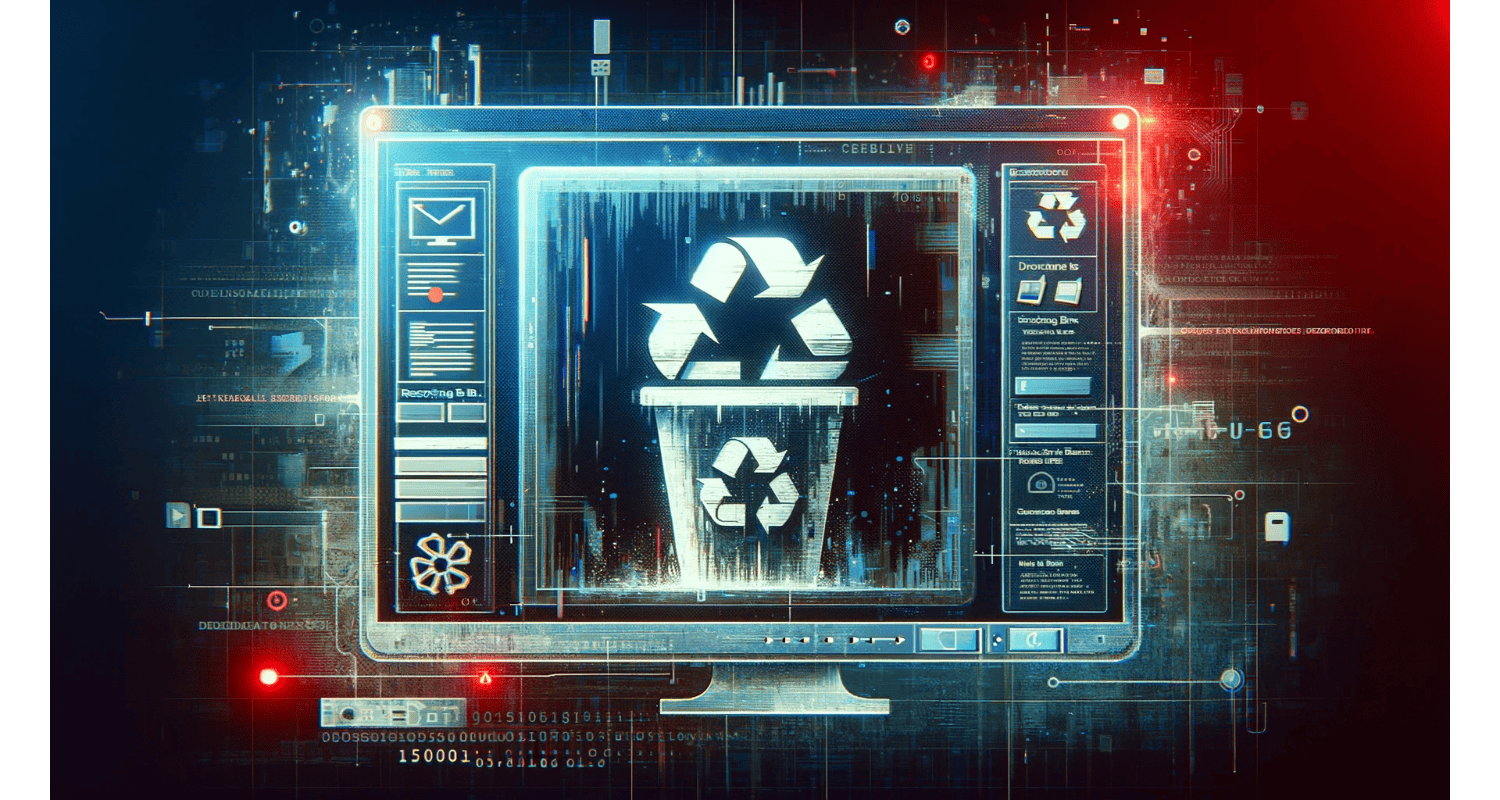Imagine your computer as a bustling city and the Recycle Bin as its waste management system. Now, picture this system suddenly breaking down. Chaos ensues – deleted files linger, unable to be restored or permanently removed. This isn’t just an inconvenience; it’s a clog in your system’s efficiency, a silent disruptor of your digital harmony. When the Recycling Bin is corrupted, it not only impedes your workflow but also poses a risk to the overall health of your computer.
To fix a corrupted Recycle Bin, open Command Prompt as an administrator and type `rd /s /q C:\$Recycle.bin`, then press Enter. This command resets the Recycle Bin. Restart your computer, and the Recycle Bin should be restored, functioning generally without corruption.
The alarm bells are ringing – ignoring this issue could worsen system problems. But fear not, there’s a beacon of hope. You can restore order and functionality with a few simple steps, turning this digital pandemonium into a seamless, efficient process. Let’s dive into how to conquer this challenge as the Recycling Bin is corrupted and reinstate your computer’s smooth operation.
See Also: Fix : “PS4 Database Corrupted” Error on PS4
Table of Contents
Method 1: Resetting The Recycle Bin Via Command Prompt (CMD)
Resetting your Recycle Bin through the Command Prompt is like performing a magic trick on your computer. Hence, it’s quick, effective, and can solve the mystery of as the Recycling Bin is corrupted bin in no time. Here’s how to do it:
- Open Command Prompt As Administrator: First, we need to get into the command center of Windows. Type ‘cmd’ in the Windows search bar, then right-click on ‘Command Prompt’ and select ‘Run as administrator.’ It’s important to have administrative privileges to perform this operation as the Recycle Bin is corrupted on external hard drive.
- Enter The Reset Command: Once the Command Prompt window is open, type the following command:
bash
Copy code
rd /s /q C:\$Recycle.bin
This command is your digital wand. The rd stands for ‘remove directory,’/s for removing all directories and files in the specified path, and /q for a quiet mode that doesn’t prompt you before deletion. - Execute And Restart: After entering the command, hit Enter. Hence, this action resets the Recycle Bin for the C: drive. If you have other drives, repeat the command for each (e.g., replace C: with D:). Now, restart your computer. This is like turning the page to a new, error-free chapter. For a more comprehensive understanding of Command Prompt operations and their impact on your system, check out our guide on Windows 10 file explorer won’t open.
Method 2: Running The System File Checker Tool (SFC)
The System File Checker (SFC) tool is like a detective for your system files. Hence, it scans through the Windows system files, looking for any inconsistencies or corruption, especially those that could be causing your Recycle Bin woes.
- Access The Command Prompt With Admin Rights: Launch the Command Prompt as an administrator, just like we did in the previous method.
- Initiate The SFC Scan: Now, type the following command and press Enter as the Recycling Bin is corrupted:
bash
Copy code
sfc /scannow
This command instructs the SFC tool to scan all protected system files and repair any corrupted files with a cached copy in a compressed folder at %WinDir%\System32\dllcache. - Wait For The Scan To Complete: Patience is key here. The scan can take some time, depending on your system’s speed and the extent of the file corruption. During this scan, SFC checks the integrity of every protected system file and repairs files if necessary as the Recycle Bin on C is corrupted Windows 11.
- Review The Results And Take Action: Once the scan is complete, you’ll see one of three messages:
No Integrity Violations: This means all is well, and your issue lies elsewhere.
Found Corrupt Files And Repaired Them: Great news! This indicates that any corruption was fixed.
Found Corrupt Files But Was Unable To Fix Some (or All) Of Them: In this case, you might need to perform a more advanced repair using the DISM tool or seek professional help. - Restart Your Computer: After the scan and any repairs, reboot your computer. Hence, this ensures all changes take effect.
Running the SFC tool is non-intrusive and doesn’t affect your files. Learn more about the System File Checker tool and its applications in our detailed article on how to fix Windows doesn’t have a network profile for this device error.
Method 3: Deleting And Reinstalling The Recycle Bin
Sometimes, the best solution to a corrupted Recycle Bin is a clean slate: deleting and reinstalling it. Here’s how to do it:
- Open The Control Panel: Navigate to the Control Panel, a familiar tool for tweaking various aspects of your Windows environment.
- Access ‘Personalization’ Settings: Click on ‘Appearance and Personalization,’ then select ‘Personalization.’ It’s like choosing a new outfit for your system.
- Adjust Desktop Icons Settings: Click ‘Change desktop icons in the left pane.’ This opens the window where you can add or remove familiar desktop icons.
- Uncheck The Recycle Bin: Find the Recycle Bin in the list and uncheck it. This effectively removes the Recycle Bin icon from your desktop. It’s like making the Recycle Bin take a brief hiatus when the Recycle Bin on E is corrupted.
- Apply Changes And Reboot: Click ‘Apply’ then ‘OK,’ and restart your computer. Hence, this step is essential as it allows the changes to take effect.
- Recheck The Recycle Bin To Reinstall: Return to the ‘Change desktop icons’ settings after rebooting and recheck the Recycle Bin. This brings it back to your desktop, fresh and new.
See Also: How to fix the MSVCP140.dll missing error on Windows?
Method 4: Scanning For Malware And Viruses
Malware and viruses can be sneaky culprits behind the Recycling Bin is corrupted. Regular malware scans are crucial for maintaining not just the Recycle Bin’s health but your system’s overall security.
Using Windows Defender:
- Open Windows Security: Search for ‘Windows Security’ in the search bar and open it.
- Select ‘Virus & threat protection’: This is your frontline defense against malware.
- Run A New Advanced Scan: Choose ‘Scan options’ and then select ‘Full scan’ for a thorough checkup. You can also opt for a ‘Quick scan,’ but it’s less comprehensive.
- Start The Scan And Wait: Click ‘Scan now’ and give it time to comb through your files. Hence, it’s like a digital detective scouring every corner for unwanted intruders.
See Also: Troubleshooting Steam Won’t Go Online Issue
Using Third-Party Antivirus Software:
- Open Your Antivirus Program: If you have a third-party antivirus, open it from the system tray or the start menu.
- Locate The Scan Option: Each antivirus has its unique interface, but generally, you’ll find a ‘Scan’ or ‘Check’ option.
- Choose The Type Of Scan: Opt for a complete scan to check every part of your system as the Recycle Bin on C is corrupted black screen.
- Initiate The Scan: Start the scan and let the software do its job. Using the computer sparingly during this time is crucial to allow the antivirus to work efficiently.
After the scan, if any malware is found, follow the prompts to remove or quarantine the threats. Regular scanning, alongside other preventive measures, can keep your Recycle Bin and the entire system running smoothly and securely. To ensure comprehensive protection, familiarize yourself with our guide on how to remove Win32:BogEnt, which can provide additional insights into safeguarding your system against malware.
Preventive Measures And Best Practices
To keep your Recycle Bin functioning smoothly as the Recycling Bin is corrupted and prevent future corruption, consider these tips and regular maintenance strategies:
- Update Regularly: Keep your operating system up-to-date. Updates often include patches for security vulnerabilities and fixes for known issues that could lead to system corruption.
- Install Reliable Antivirus Software: Protect your system from malware and viruses, known catalysts for system file corruption. Regularly update and scan your system with this software.
- Be Cautious With Software Installations: Only install software from trusted sources. Hence, unreliable or malicious software can modify system settings and files, leading to issues like Recycle Bin corruption.
- Regularly Back Up Your System: Implement a robust backup strategy. Regularly backing up your system, including important files and system settings, can save you from data loss in case of corruption.
- Avoid Abrupt Shutdowns: Always shut down your computer correctly. Abrupt shutdowns can cause system file corruption.
- Clean Up Your System: Use system cleanup tools regularly to eliminate unnecessary files and reduce the load on your system. A lighter, well-managed system runs more efficiently and is less prone to errors as the Recycling Bin is corrupted Windows 10.
- Monitor System Health: Monitor your system’s health using built-in or third-party tools. Hence, early detection of issues can prevent them from escalating.
- Educate Yourself: Stay informed about standard system issues and their solutions. Being knowledgeable can help you avoid practices that lead to system problems. For more tips on system maintenance and efficiency, take a look at our recommendations on fixing a slow and unresponsive Windows 10.
FAQs
How do you fix a corrupted Recycle Bin in Windows?
To fix a corrupted Recycle Bin in Windows, you can use the Command Prompt. First, launch it as an administrator, then type rd /s /q C:$Recycle.bin and press Enter. Repeat this for other partitions by changing C: to the appropriate drive letter. After executing this command for all drives, restart your computer, and Windows will create a new Recycle Bin .
What causes the Recycle Bin to become corrupted?
The Recycle Bin can become corrupted for various reasons, such as unexpected system shutdowns, system file corruption, or malware and virus infections. Understanding and addressing these root causes can prevent future instances of corruption .
Can I reset the Recycle Bin without using Command Prompt?
Yes, you can reset the Recycle Bin without using Command Prompt. This involves manually deleting the $Recycle.Bin folder from File Explorer. First, show hidden files and folders, then navigate to C:$Recycle.Bin and delete its contents. Restart your computer afterward, and Windows will automatically create a new Recycle Bin .
Can I recover deleted files from the Recycle Bin after emptying it?
Yes, it's possible to recover deleted files from the Recycle Bin after emptying it. However, this typically requires data recovery tools like Disk Drill, which can scan your drive and potentially recover lost files .
Will resetting the Recycle Bin delete the files in it?
Yes, resetting the Recycle Bin will delete all files currently in it. Therefore, it's essential to back up or recover any critical files from the Recycle Bin before resetting it .
See Also: 7 Fixes When Your Valorant Won’t Open
Conclusion
In conclusion, maintaining a healthy Recycle Bin, and by extension, a robust system, involves a blend of proactive measures and reactive solutions. We’ve explored methods like resetting the Recycle Bin via CMD, running the System File Checker tool, deleting and reinstalling the Recycle Bin, and scanning for malware.
Remember, prevention is critical. Regular system updates, cautious software installations, routine backups, and antivirus scans are your first defense against issues like Recycle Bin corruption. Hence, treating these practices as part of your digital routine can go a long way in maintaining the health of your computer.
Ultimately, a well-maintained Recycle Bin is just one part of a broader strategy for a robust and efficient system. Hence, by regularly employing these methods and adhering to best practices, you can ensure a smoother, more reliable computing experience and avoid the pitfalls of Recycle Bin corruption.
See Also: Dealing with the ERR_NETWORK_CHANGED Error in Browsers

Robert Irvine, How-To Editor at Automaticable, writes tech tutorials since dial-up days. Former editor of Web User magazine, he’s also a cooking enthusiast (not the celebrity chef).

